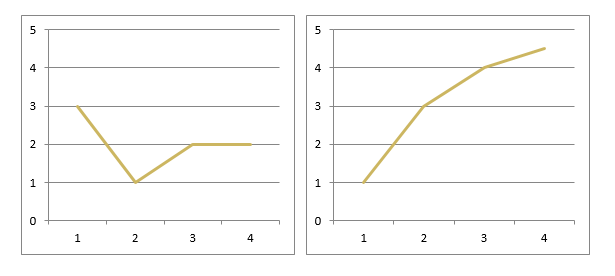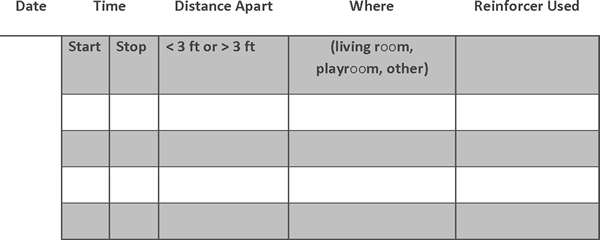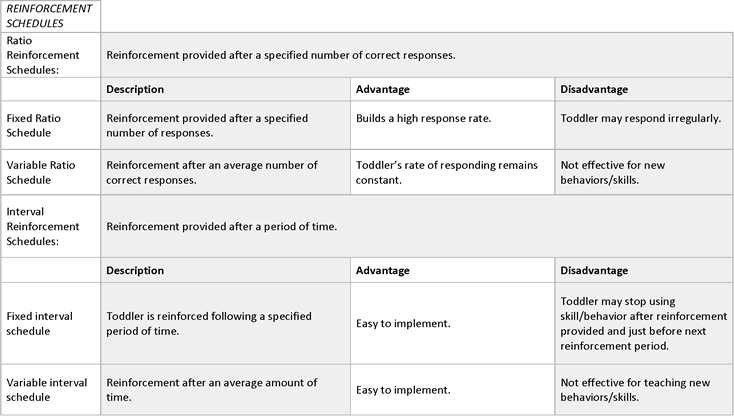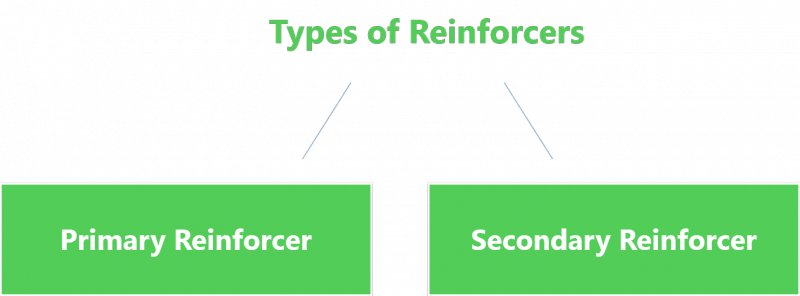Step 1 Planning
![]()

The following steps describe the process by which to identify the toddler’s skill or behavior that will be targeted for the Positive Reinforcement intervention. The planning steps also describe how to identify and select reinforcers. Finally, this planning section describes schedules for reinforcement.
Step 1.1 Select and describe the target skill or behavior in observable and measurable terms
Beginning with the IFSP, the EI team discusses with the parent the strengths and challenges of the toddler in meeting a priority outcome and then describes the target skill. The IFSP outcome should be observable and measurable in order to be able to clearly describe the expected skill that the toddler will learn and how to determine when the toddler has mastered the skill.
EXAMPLE
Parents discussed with the providers that their toddler, Jonathan, doesn’t interact with them or his 5 year old sister at home.
The IFSP team initially wrote the outcome as: “Jonathan will play with his sister after day care.”
While the outcome describes the family’s hope, it is not observable and measurable and thus difficult to observe progress on over time. Different people would have different ideas of what “play” means and what it would mean for Jonathan to do it successfully. This IFSP outcome was re-written so that it was observable and measurable. To do this, the team clearly described the context (WHEN), the target skill the toddler will perform (WHAT) and how will we know Jonathan has mastered this skill (HOW).
New outcome: After daycare and before dinner, Jonathan will send at least 5 minutes interacting with his toys within 3 feet of his sister for 4 out of 5 days.
Step 1.2 Identify the activities and routines within which to teach the target behavior (or skill)
Once target behaviors are described, the EI team and parents identify everyday activities and routines within which to use positive reinforcement to increase the toddler’s behavior. Using favorite activities and routines will further increase motivation through the use of natural reinforcers for the toddler. Using family activities and routines will also support the family and other caregivers in implementing reinforcement on their own.
EXAMPLE
The team and family might decide to use reinforcement of the toddler’s requesting behaviors (signing “more” and reaching, saying “I want ___”) during highly preferred routines such as bath or snack.
For Jonathan, described in example for Step 1.1, the team might identify all the times when Jonathan and his sister have opportunities to play at the same time.
Step 1.3 Determine implementation of other evidence-based practices
Reinforcement is usually implemented in conjunction with other evidence-based practices (e.g., prompting, activity-systems, naturalistic interventions, discrete trial training).
If another evidence-based practice is being implemented review the module for that practice from the Autism Internet Modules or review the EBP Brief at the NPDC on ASD website.
Step 1.4 Collect baseline data
Once the behavior (or skill) and activities and routines are identified, the team and family collect data on that behavior within those activities or routines. This will determine how often the toddler uses the target behavior, if at all.
If an accurate baseline is not established the EI team is unlikely to develop appropriate goals and criteria by which to measure progress. Further, the EI team is unlikely to be able to make the right adjustments to the implementation of reinforcement and other evidence-based practice necessary to support the toddler and family’s success.
a) The EI team, with the family, measure the toddler’s use of the skill or behavior
Review the criteria written into the IFSP outcome to identify what type of data to collect. These types of data might include the following:
Frequency Data. Frequency data measure how often the toddler engages in the skill/behavior. Data are collected through time sampling or event sampling.
When using time sampling, data are collected after a certain amount of time has passed (e.g. every 5 minutes). For example, if collecting data on frequency of screaming behavior a parent or provider would mark if the behavior happened every 5 minutes. This technique is useful for behaviors the toddler engages in frequently such as for engagement and parallel play. For Jonathan, the team could take data every 3 minutes on whether he was engaging in play within the target distance from his sister.
Event sampling is used by marking every time that the toddler engages in the skill/behavior. This technique is used for low frequency behaviors or skills such as requesting help, playing specifically with a toy, helping put on clothes, and so on. For Jonathan, the team could mark down every time he engaged directly with his sister during play.
Data: How frequently Jack requests for more snack during snack time by signing “more”, pointing to the food, or approximating the food (“cracker”)
|
Date |
# of Requests |
Total |
|---|---|---|
|
9/17/2012 |
X |
1 |
|
9/18/2012 |
X |
1 |
|
9/19/2012 |
XXX |
3 |
|
9/20/2012 |
XXXX |
4 |
Duration data. Duration data are used to record the length of time that the toddler engages in the skill/behavior. For example, a parent or provider might collect data on how long a toddler sits at the table during dinner before demanding to be let down. A parent or provider might collect data on how long the toddler spends playing with one open-ended toy before moving on to something else. For Jonathan, the team could take data on how long he engages in parallel play with his sister.
Data Table: Length of time Caroline spends in bath before demanding to be taken out
|
Date |
Start Time |
End Time |
Total Time |
Which Bathroom Used |
|---|---|---|---|---|
|
7/4/12 |
7:18 |
7:21 |
3 |
Guest |
|
7/5/12 |
6:55 |
6:59 |
4 |
Guest |
|
7/7/12 |
7:02 |
7:07 |
5 |
Master |
|
7/8/12 |
7:22 |
7:24 |
2 |
Guest |
b) EI team members collect baseline data for a minimum of four days or until a trend is clear and stable before beginning implementation of reinforcement.
If the baseline is not stable, the team will not know whether it was the implementation of reinforcement that produced a change in the toddler’s behavior or use of a skill. A stable baseline helps the team know whether their use of reinforcement is impacting the toddler’s behavior.
Baseline data should be graphed in order to best determine if a trend is stable such as in the following graphs. In both of the graphs below a stable trend can be identified. While the graph on the left is more erratic, it is clear that the frequency or duration of the behavior is at the level of a 2 and that the level is overall flat. The graph on the right clearly slows an increasing trend. Generally, at least 3 data points are needed to begin to identify a trend.

Step 1.5 Establish goals and criteria
Now that the team and family have identified skills/behaviors and routines, they determine the criteria that will be used to evaluate whether their use of positive reinforcement is effective. First, the team and family double check that the outcome is still appropriate given the baseline data collected. If it is not, the outcome is revised as described in the first step.
EXAMPLE
After daycare and before dinner, Jonathan will send at least 5 minutes interacting with his toys within 3 feet of his sister for 4 out of 5 days.
In Jonathan’s outcome there are multiple, clear criteria by which to measure success:
- duration of interaction with toys
- proximity to his sister
- across specific number of days
Each of these are important to track to identify when Jonathan is having trouble or making progress.
A data sheet for Jonathan’s IFSP outcome would include the following:

Step 1.6 Select positive reinforcers
The goal of reinforcement is to increase the likelihood that the toddler with ASD will use the target skill again in the future. Therefore, selected reinforcers should be highly motivating to the toddler with ASD, naturally reinforcing, and tied to the activity or routine within which the target skill or behavior will be most likely used by the toddler.
When choosing reinforcers for toddlers with ASD, the EI team identifies:
- What has motivated the toddler in the past?
- What does the toddler want that is not easily accessible by her?
For example, a toddler may continually request Goldfish crackers that are placed on a high shelf; however, the EI provider or parent only gives the toddler the Goldfish crackers a few times a day.
EI providers, parents, and/or caregivers identify a reinforcer that is appropriate for the target skill and routine or activity.
Primary reinforcers satisfy a physical need by making the toddler feel good (e.g., food, liquids, sleep).
Secondary reinforcers are objects or activities that the toddler has grown to like, but does not need biologically (e.g., tickles, stickers, ball play).
Potential Reinforcers
- Activity reinforcers include tickles with dad, going outside, time to play games on iPad, access to a bubble blower.
- Social reinforcers include verbal praise (e.g., “You did it! You put the ball in!”), “high fives”, and general body language indicating approval. Social reinforcers should be paired with other reinforcers, especially natural. Social reinforcers should also be varied and specific to the skill/behavior. A string of “good jobs” quickly become meaningless and do not tell the toddler what he did well. It is important to remember that while social reinforcers are motivating for many children, they may be less or not at all motivating for toddlers with ASD. In this case, a social reinforcer may get in the way or frustrate the toddler.
- Tangible reinforcers include objects that the toddler with ASD acquires after displaying the skill/behavior. Examples include stickers, toys, crackers, and popcorn.
- Sensory reinforcers are often motivating for toddlers with ASD. The use of these can be considered if the caregiver can control access to them, are deemed appropriate by the family, and other reinforcers have not been identified. Sensory reinforcers may include sitting in a rocking chair, getting lotion applied to hands, or playing with a favorite spinning top, to name a few.
- Natural reinforcers as those that would occur normally as a result of the child’s skill/behavior. Examples include receiving a toy after asking for it, the cow popping out of the toy after the button is pushed, or receiving a turn on the swing after requesting “swing.”
The chosen reinforcer should be as natural as possible. That is, it should be related to the activity that is going on. For example, it would be natural for a toddler with ASD to get free time or have access to a preferred activity/object after taking part in a challenging, non-preferred learning activity. Another example would be to use food as a reinforcer during food-related activities such as snack time or lunch when the target skill is requesting.
Activities Used to Identify Effective Reinforcers for a Toddler
-
Use an Interest Inventory
The family and other caregivers are likely to give valuable information about the toddler’s preferences. The Early Preschool Interest-Based Everyday Activity Checklist [ PDF file ] is one example of a checklist to use to gather information from the toddler’s family about preferred activities. This checklist provides information on activities that are reinforcing as well as the frequency of these activities within family routines and can be found at the Family, Infant, and Preschool Program Center for the Advanced Study of Excellence (CASE) website: www.fipp.org
- Observe the toddler in natural settings and identify activities, objects, foods, interactions, and so on that she chooses or seems to enjoy.
- Ask the toddler, if appropriate, what he would prefer to work for by providing the toddler with choices. For example, show the toddler two options of snack, wait for toddler to point to one he would like (if this skill is developed). Later, put the snack out of reach and instruct the toddler on how to request the snack. Reinforce with the chosen snack when toddler requests.
-
Conduct a Reinforcer Sampling
In order to decide which reinforcers, among many, are most likely to be effective conduct a reinforcement sampling. There are a number of options for completing reinforcer sampling; however, for toddlers who may have limited communication skills, the following steps are suggested:
- Gather a selection of items that may be favorable to the toddler. These items can be identified by asking caregivers and observing the toddler.
- Present the toddler with pairs of choices, being sure to match each item at least once with the other items being sampled. This is to determine relative preference. Also, vary left and right presentation throughout to minimize the possibility that the toddler is choosing one object from a particular side (e.g. side preference).
- Document the items chosen most often, least often, or that produce a notable response (e.g., the toddler throws the item after choosing it). Toddler Activities, Reinforcer Sampling, or Preference Assessment Menu (Fisher et al., 1992)
|
Date |
Reinforcer 1 |
(+) or (-) |
Reinforcer 2 |
(+) or (-) |
Notes |
|---|---|---|---|---|---|
|
5/01/12 |
Bubbles |
+ |
Coloring/drawing |
- |
|
|
5/01/12 |
Bubbles |
+ |
Squishy ball |
- |
|
|
5/01/12 |
Play Doh |
- |
Squishy ball |
+ |
|
|
5/01/12 |
Squishy ball |
+ |
Favorite book |
- |
|
|
5/01/12 |
Favorite book |
+ |
Play doh |
- |
|
|
5/02/12 |
Favorite book |
- |
Duplo Blocks |
+ |
|
|
5/02/12 |
Duplo Blocks |
+ |
Play doh |
- |
|
|
5/02/12 |
Duplo Block |
+ |
Coloring/drawing |
- |
|
|
5/02/12 |
Playdoh |
+ |
Coloring/drawing |
- |
|
|
5/02/12 |
Swinging |
+ |
Sitting in rocking chair |
- |
Super excited |
|
5/02/12 |
Swinging |
+ |
Trampoline |
- |
About swing! |
The following video demonstrates a provider using the reinforcement sampling technique to identify which object is most or least motivating to the child. The provider introduces the toddler to two objects and watches which object the child explores or plays with more enthusiastically or for a longer period of time.
 Video: Reinforcer Sampling
Video: Reinforcer Sampling
Through the above steps, the team develops a list of reinforcers and reinforcing activities.
Step 1.7 Select a schedule of reinforcement
The schedule for reinforcement refers to the timing and frequency of the delivery of reinforcement after the toddler performs the skill/behavior. Reinforcement is delivered either continuously or intermittently.
Generally, continuous reinforcement means the reinforcement is delivered each time the toddler uses the skill/behavior until the skill/behavior is learned. Continuous reinforcement helps the toddler learn new skills quickly, but can lead to satiation. Once the toddler learns the behavior, as evidenced by them meeting a pre-established criterion, the reinforcement may be delivered intermittently. Intermittent reinforcement helps to maintain the skill/behavior over time, and should be used after the toddler learns the new skill/behavior.
Moving from a continuous to an intermittent schedule of reinforcement is an example of reinforcement fading. Fading of reinforcement is an important step to helping the toddler learn to use the skill without the need of secondary reinforcers so that he or she can better generalize the target skill/behavior to other people, places, and activities. Intermittent reinforcement schedules can be either ratio or interval. Ratio schedules deliver reinforcement after the toddler does the skill/behavior. Interval schedule reinforcement is provided after a certain amount of time has passed.
Both ratio and interval schedules can be fixed or variable. Once the toddler learns the skill better, using these schedules ensures higher rate of success since the toddler isn’t aware of when reinforcement will be provided. Providers and families generally use a variable schedule as they provide reinforcement. At home, mom and dad have their attention pulled in various directions and will find it more challenging to provide reinforcement for every occurrence of the toddler’s skill/behavior. The following chart describes in more detail the differences between these reinforcement schedules.

The following video shows an example of fixed ratio reinforcement and variable ratio reinforcement.
 Video: Fixed and Variable Ratio Reinforcement
Video: Fixed and Variable Ratio Reinforcement
In determining the best schedule for providing reinforcement to the toddler remember the following:
- General continuous reinforcement is best as the toddler learns a new skill.
- Fixed schedules are more effective for shaping behavior.
- Variable schedules are useful for helping a toddler maintain a skill.
The following table summarizes the different reinforcement schedules:

Planning Scenarios: Positive Reinforcement
The practice scenarios for using the evidence-based practice (EBP) follows a toddler example through each of the implementation steps. The practice scenarios are followed by a Knowledge Check for each step. We recommend that you select and follow the same setting (home or center-based) throughout the module steps.
If you have trouble viewing, review the Troubleshooting Tips
Knowledge Check

Question:
What type of reinforcement schedule is best for maintaining a skill or behavior that the toddler has already learned?
Question:
When teaching a new skill, which reinforcement schedule is most effective to start with?
Consider the following question:
What are at least three types of reinforcers?


